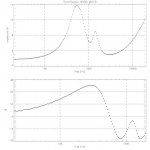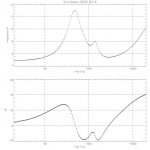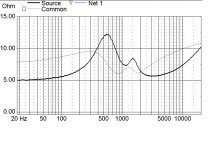Has anyone seen the free air impedance curve like this before? The driver is a ScanSpeak 9500 just out of the box. I've measured other tweeters using the same method with no double resonance like this. Will this go away after sufficient break-in or do I need to add complexity to my crossover?
Attachments
The manufacturers measurements shows a similar second hump in the impedance curve. I don't know what it is or what to do about it, and I doubt that it will go away with time.
http://www.d-s-t.com/scs/data/d2905_950000c.htm
http://www.d-s-t.com/scs/data/d2905_950000c.htm
You can only assume it is a deliberate acoustic resonator in the
tweeter included for a particular purpose. It will not go away.
I'd suggest it maintains response in the 1K to 2K region.
Other Scanspeak tweeters show a mild bump in the
impedance in this region but a roll-off beginning at 2K.
Its possible you have tweeters made for a particular manafacturer
with lower than standard specifications damping, but I don't think
the resonance will cause a frequency response "Bump".
Care is needed in the crossover, avoid odd order designs,
even order croosovers and any parrallel resistance (of a
series / parallel attenuator) will help supress the resonance
effect and indeed the main resonance effect.
🙂 sreten.
tweeter included for a particular purpose. It will not go away.
I'd suggest it maintains response in the 1K to 2K region.
Other Scanspeak tweeters show a mild bump in the
impedance in this region but a roll-off beginning at 2K.
Its possible you have tweeters made for a particular manafacturer
with lower than standard specifications damping, but I don't think
the resonance will cause a frequency response "Bump".
Care is needed in the crossover, avoid odd order designs,
even order croosovers and any parrallel resistance (of a
series / parallel attenuator) will help supress the resonance
effect and indeed the main resonance effect.
🙂 sreten.
the double impedance is normal with chambered tweeters
but the 2nd peak is much smaller most of the time. your graph looks odd, the ferrofluid should damp the peaks much, and scan speak tells the chamber to be non resonnant...
but the 2nd peak is much smaller most of the time. your graph looks odd, the ferrofluid should damp the peaks much, and scan speak tells the chamber to be non resonnant...
is it the scale?
I noticed the slight impedance blip at ~1.5 kHz in the manufacturer data but it looked significantly smaller than what I observed. Perhaps it is somewhat due to their scaling which appears to double impedance every division.
Also thanks for the crossover advice. I was wondering though whether I should be spending extra effort and cost to design a crossover for a speaker which is non-standard? The other tweeter looks the same, although there seems to be an overall impedance shift of about 1 ohm....now I regret not buying those matched pairs of tweeters... I'm going to double check this today.
here is the other tweeter,
I noticed the slight impedance blip at ~1.5 kHz in the manufacturer data but it looked significantly smaller than what I observed. Perhaps it is somewhat due to their scaling which appears to double impedance every division.
Also thanks for the crossover advice. I was wondering though whether I should be spending extra effort and cost to design a crossover for a speaker which is non-standard? The other tweeter looks the same, although there seems to be an overall impedance shift of about 1 ohm....now I regret not buying those matched pairs of tweeters... I'm going to double check this today.
here is the other tweeter,
Attachments
- Status
- Not open for further replies.
- Home
- Loudspeakers
- Multi-Way
- tweeter double resonance?


